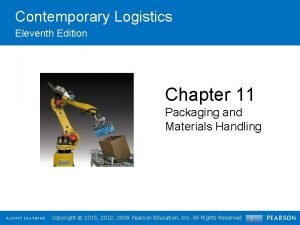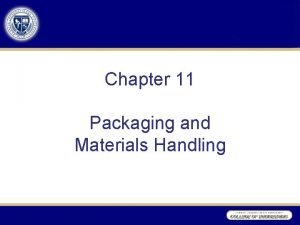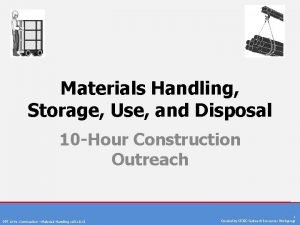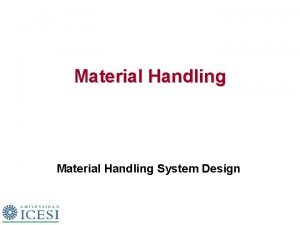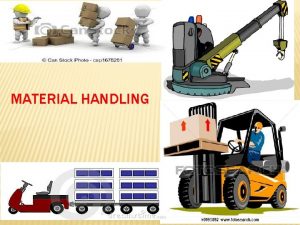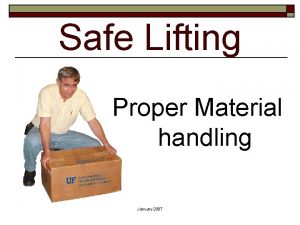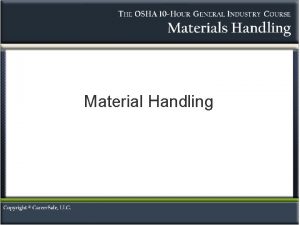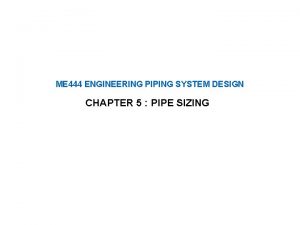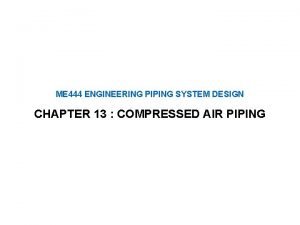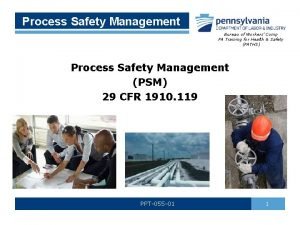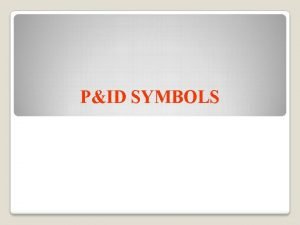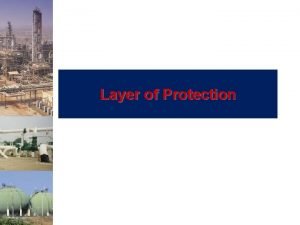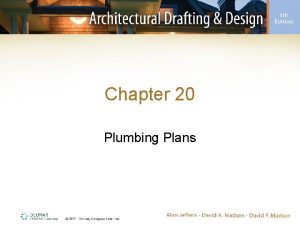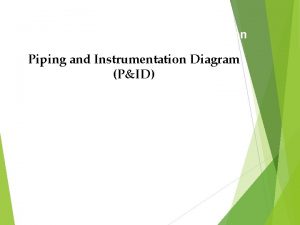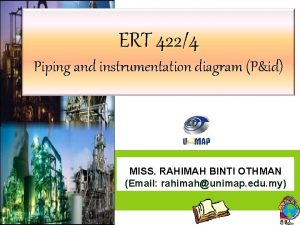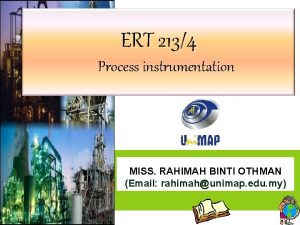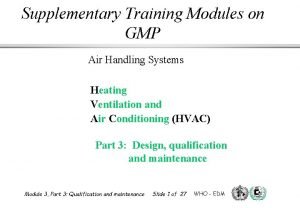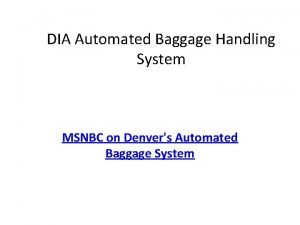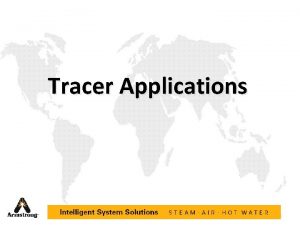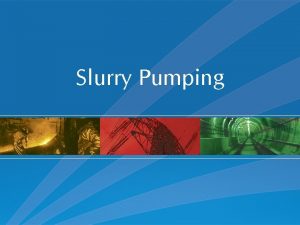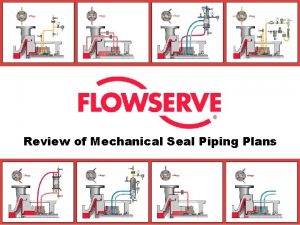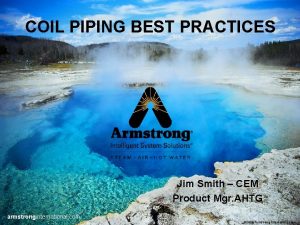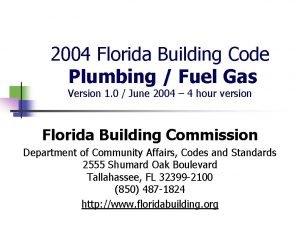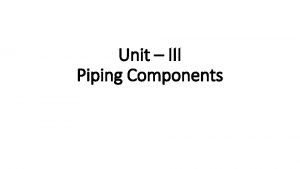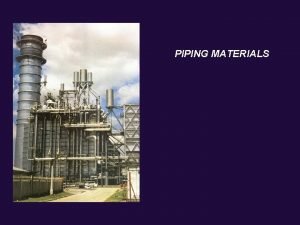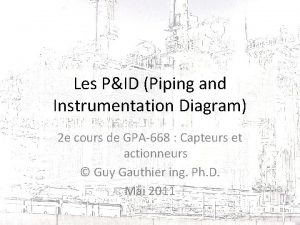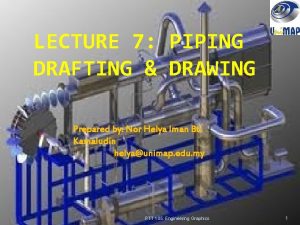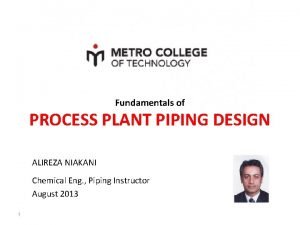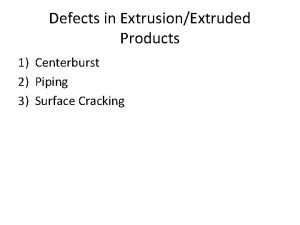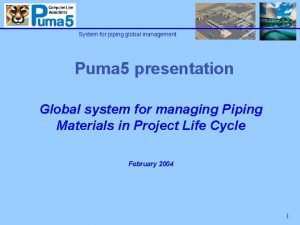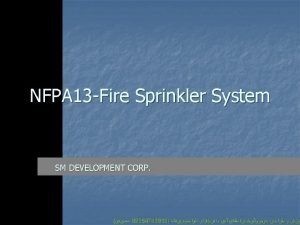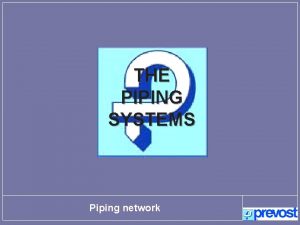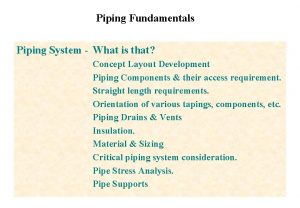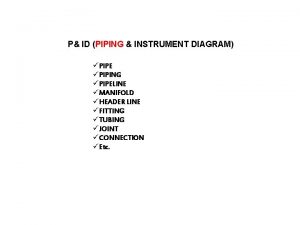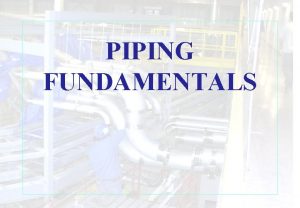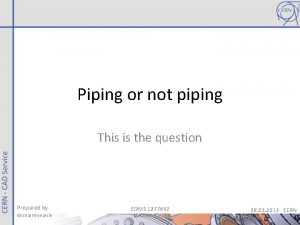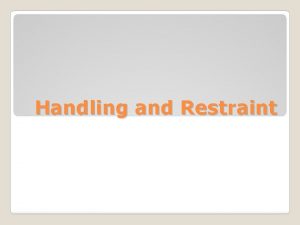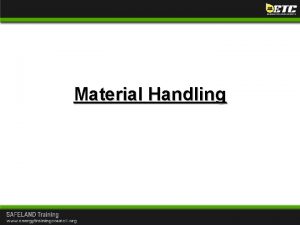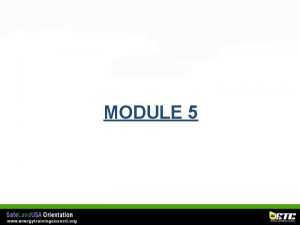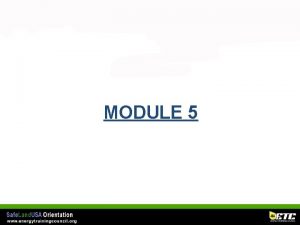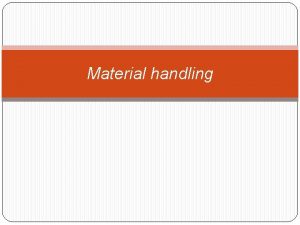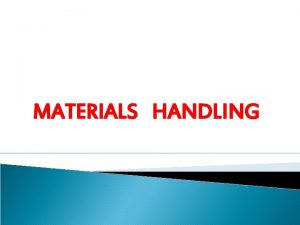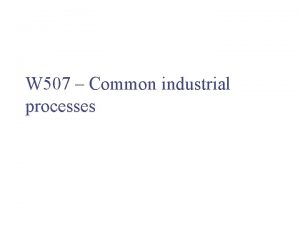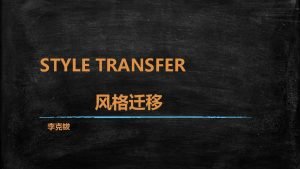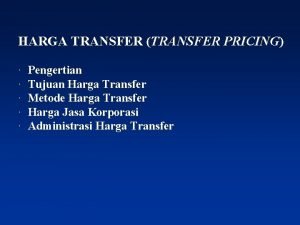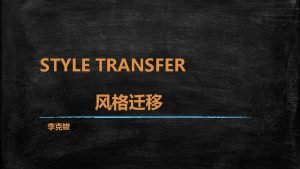Materials Handling and Transfer Piping Systems Piping System













































- Slides: 45

Materials Handling and Transfer “Piping Systems”

Piping System Definition: Interconnected piping subjected to the same design conditions. Piping system components 1. Pipes 2. Fittings (flanges, threaded, welded) 3. Valves 4. Expansion joints 5. Strainers 6. Traps 7. Inline instruments 8. Supports (anchors)

Identification Systems ASTM System


PVC pipes take the letter D

Pipes specifications: Pipes are specified according to wall thickness by a standard formula for schedule number ØOn increasing schedule number, the pipe wall thickness increase




What is the nominal diameter? The ND code is a code that rounds off the diameter of the pipe to get an even number to work with, not the exact diameter. The American version is called NPS (Nominal Pipe Size) and is in English units. ND is the European version and is based on millimeters. For example, If you want 2" Pipe, NPS calls it 2" and ND calls it 50 mm. but the actual outside diameter is neither 2" or 50 mm. They just use these nice round numbers cause it is easier.

Pipe Sizing 1 - Wall Thickness tm: is the minimum required thickness Dm: mean diameter 2 - Optimum Diameter



Fittings and other piping auxiliaries. Are used to: A- Connect pieces of pipes together B- Change the flow direction C- Regulate the flow D- Obtain desired conditions in a flow system Types of fittings 1 - Threaded fittings( screwed) [for small size] 2 - Flanges [for diameter 3 in. ] 3 - Welding

Threaded (screwed) fittings

Threaded (screwed) fittings

Flanged fittings

Flanged fittings

Piping Systems Problems 1 - Solidification and corrosion 2 - Thermal expansion 3 - Liquid pockets

Liquid pockets They can be caused by gas/liquid getting into a liquid/gas pipe. Sometimes the pressure or temperature of the fluid within a pipe will change and that can allow phase change, or gases to escape out of a liquid, or gases to condense. e. g. Steam lines contain hot gaseous steam, but as this steam cools down, condensate(liquid water) starts forming. If water within a pipe gets hot some may boil (causes "boiler rumbling"). Carbonated drinks hold a lot gas when under pressure, when it's realized the gas/liquid separate. Air holds a fair bit of moisture, Increase it's pressure, or drop it's temperature and moisture will drop of it. Similar thing with natural gas.

Øliquid pockets can cause problems as slug of liquid can then be forced down the pipe at high speed. When it hits something, it's comes to a very quick stop. The liquid is effectively incompressible and so it's KE is converted into a VERY fast rise in pressure, and that can rupture the pipe/fitting (Water hammer).

Steam trap A steam trap is a device used to discharge condensate and non condensable gases with a negligible consumption or loss of live steam. Most steam traps are nothing more than automatic valves. They open, close or modulate automatically. The three important functions of steam traps are: ØDischarge condensate as soon as it is formed. ØHave a negligible steam consumption. ØHave the capability of discharging air and other non-condensable gases.

How to overcome the solidification problem in pipelines? Pipe Launcher

Smart Pig


Smart Pig

Smart Pig Inside the Pipe

Magnetic sensor Pipe wall Pig body


Pipe Expansion and Support ØAny piping system must be fully supported, able to expand during operation and sufficiently flexible to allow movement as a result. ØAll pipes will be installed at ambient temperature. ØPipes carrying hot fluids such as water or steam operate at higher temperatures. ØIt follows that they expand, especially in length, with an increase from ambient to working temperatures. ØThis will create stress upon certain areas within the distribution system, such as pipe joints, which, in the extreme, could fracture.

Calculation of the amount of expansion The amount of the expansion is readily calculated using Equations, or read from an appropriate chart. Expansion coefficients (α) (mm/m °C x 103)

A chart showing the expansion in various steel pipe lengths at various temperature differences

ØThe fixed or 'anchor' points 'A' provide a datum position from which expansion takes place. ØThe sliding support points 'B' allow free movement for expansion of the pipe work, while keeping the pipeline in alignment. ØThe expansion device at point 'C' is to accommodate the expansion and contraction of the pipe.

Pipe Support Chair and roller Chair roller and saddle

Expansion Fittings 1 - Full loop ØThis is simply one complete turn of the pipe and, on steam pipe work, should preferably be fitted in a horizontal rather than a vertical position to prevent condensate accumulating on the upstream side.

2 - Horseshoe or lyre loop

3 - Expansion loops Expansion loop



Expansion loop capacity for carbon steel pipes

4 - Sliding joint

5 - Expansion bellows Simple expansion bellows An expansion bellows, has the advantage that it requires no packing as does the sliding joint type.

Expansion bellows

Expansion bellows

ØBellows may incorporate limit rods, which limit over-compression and over-extension of the element.
 Protective packaging and materials handling
Protective packaging and materials handling Packing learning objectives
Packing learning objectives A way to prevent materials handling hazards is to ___.
A way to prevent materials handling hazards is to ___. Care of library materials
Care of library materials Unit load definition
Unit load definition Define material handling system
Define material handling system Proper handling of materials
Proper handling of materials Introduction to materials handling
Introduction to materials handling Cant stop the feeling go noodle
Cant stop the feeling go noodle Materials that are useful
Materials that are useful Man made materials
Man made materials Differentiate adopting materials and adapting materials
Differentiate adopting materials and adapting materials Me 444
Me 444 Me 444
Me 444 Mgi mena
Mgi mena A disturbance that transfers energy
A disturbance that transfers energy Direct materials budget with multiple materials
Direct materials budget with multiple materials 3 modern materials
3 modern materials Unit 2 energy, materials, systems and devices answers
Unit 2 energy, materials, systems and devices answers Piping and instrumentation diagrams
Piping and instrumentation diagrams Pid symbols
Pid symbols Layers of protection
Layers of protection Plumbing and piping plan
Plumbing and piping plan Pfd boiler
Pfd boiler Fe instrumentation symbol
Fe instrumentation symbol Piping and instrumentation diagram (p&id)
Piping and instrumentation diagram (p&id) Oq training modules
Oq training modules Denver airport automated baggage handling system
Denver airport automated baggage handling system Decision support systems and intelligent systems
Decision support systems and intelligent systems Steam tracing piping
Steam tracing piping Slurry pump suction piping
Slurry pump suction piping Plan 11 seal
Plan 11 seal Creo piping
Creo piping Rsysconfig
Rsysconfig Steam coil piping
Steam coil piping Florida building code gas piping
Florida building code gas piping Piping component
Piping component Piping
Piping Schéma pid
Schéma pid Pipe engineering drawing
Pipe engineering drawing Process plant piping
Process plant piping Centerburst
Centerburst Puma5
Puma5 Piping solutions inc
Piping solutions inc Sprinkler head color coding
Sprinkler head color coding Piping
Piping
